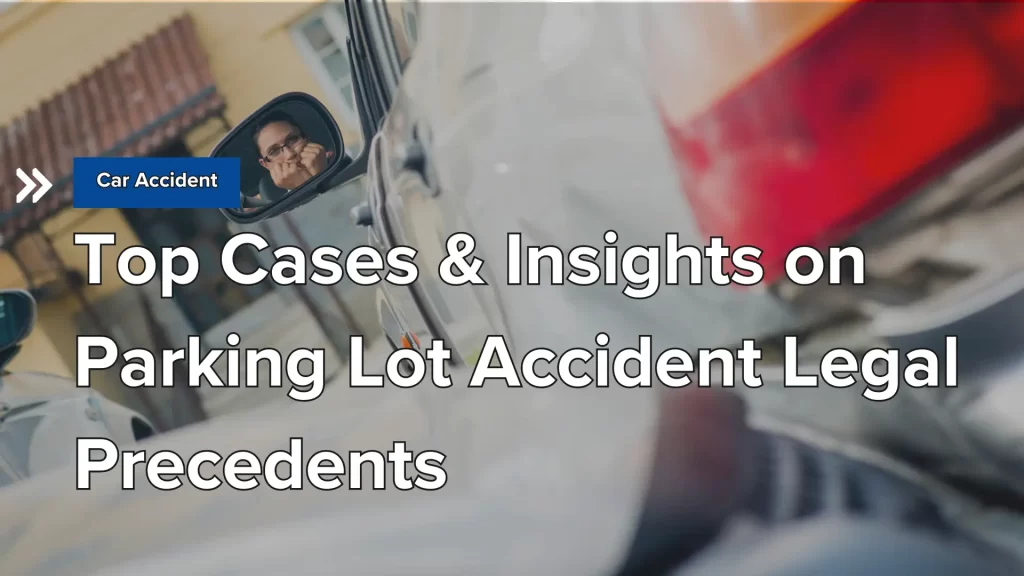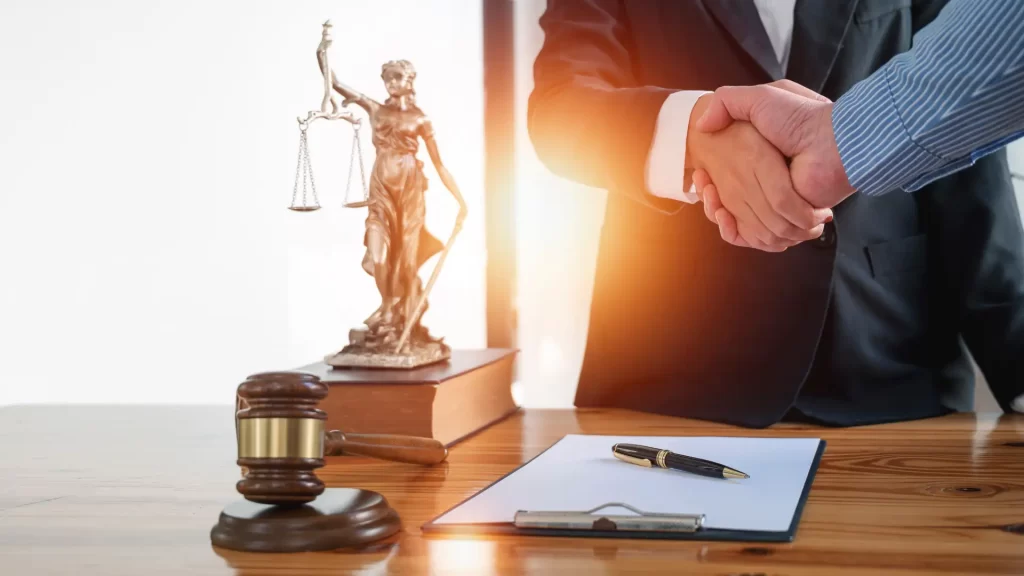
Understanding the legal precedents for parking lot accidents is crucial in determining fault and legal outcomes. Parking lot accidents are common and account for a substantial portion of annual vehicle-related incidents. It’s important to remain vigilant and have a clear understanding of the legal implications in case of an accident. Whether you are a driver, pedestrian, or property owner, having insights into the legal precedents can be helpful.
Understanding Parking Lot Accident Legal Precedents
When the unexpected happens in a parking lot, the aftermath often involves more than just exchanging insurance information. Parking lot accidents fall under a unique category of car accidents, attributed to the specific circumstances these environments present. With a mix of moving and parked vehicles, pedestrians, and a variety of lane types understanding the nuances of parking lot crash scenarios is key. Lane types such as feeder lanes and thoroughfare lanes can create issues for drivers in a parking lot.
What is the influence of past cases on parking lot claims? Parking lot legal precedents establish guidelines for determining fault, taking into account the vast array of potential situations: from collisions between two moving vehicles, one reversing into a parked car, or a distracted driver failing to notice a pedestrian. Each accident scene within a parking lot presents a different set of challenges, with the right-of-way rules playing a central role in resolving who bears responsibility.
Dealing with a parking lot accident involves understanding legal precedents. Although parking lots have lower speeds than public roads, they can lead to complex car accident scenarios. Legal precedents play a vital role in determining liability for incidents ranging from minor fender benders to serious collisions.
Key Factors Influencing Legal Decisions
In the wake of a parking lot accident, the legal process unfolds with a careful examination of several key factors. These include:
- Who had the right-of-way at the time of the collision?
- Was there any form of driver negligence, such as distracted driving or failure to yield?
- How did pedestrian behavior potentially contribute to the incident?
These questions are at the heart of the legal issues that courts and insurance companies must solve.
Illinois law, for instance, highlights the weight of pedestrian behavior and state-specific regulations when determining fault. Pedestrians, often navigating between parked vehicles, generally have the right of way, and drivers are expected to yield, maintaining a high degree of caution. how legal history shapes accident compensation. However, the state’s modified comparative fault rule adds another layer to the mix — if a pedestrian or driver is found to be more than 50% at fault, their ability to recover compensation is barred.
The right of way is a cornerstone of parking lot accident law. Here are some key rules to keep in mind:
- Thoroughfare lanes typically take precedence over feeder lanes.
- Pedestrians in aisles must be given priority.
- Drivers exiting their parking spots must be particularly vigilant, as they do not have the right of way over pedestrians.
In the dynamic environment of a parking lot, understanding these rules is paramount in navigating the legal landscape that follows an accident.
Determining Fault Based on Precedents
Determining fault in a parking lot accident is a multifaceted endeavor, with legal precedents serving as the compass. Take, for example, the common scenario of two vehicles simultaneously backing out of parking spots. In such cases, the drivers may share fault, with the specifics of maneuvering space and visibility playing a role in the determination. If a vehicle strikes a parked vehicle or stationary object, the fault typically lies with the driver due to their duty to be aware of their surroundings.
In the context of pedestrian accidents within parking lots, the scales of fault generally tip toward the driver, as pedestrians have the right-of-way. However, a pedestrian’s reckless behavior could absolve a driver from liability if it’s demonstrated that such behavior was a clear violation of safety norms. The Illinois modified comparative fault rule further refines the approach to determining fault, potentially reducing compensation based on an individual’s percentage of fault.
Fault is determined by considering both the right-of-way and the situational actions of each party involved in the incident. It is important to consider these factors to assign fault accurately. Whether a car backs up into a moving lane or a pedestrian darts out between parked vehicles, established legal precedents guide the process of fault allocation. Understanding these nuances is vital for anyone involved in a parking lot accident, as it can significantly impact the outcome of insurance claims and liability assessments.
The Role of Evidence in Legal Precedents
In the legal process surrounding parking lot accidents, evidence is the linchpin that holds a case together. Gathering evidence is especially crucial due to the informal nature of these incidents; unlike roadway collisions, police reports may not always be available, emphasizing other forms of evidence to establish fault and liability.
Eyewitness statements can offer invaluable insights into the circumstances of the accident, providing an external perspective that might clarify the sequence of events. Coupled with police reports, which document the basic facts of the incident, these forms of evidence create a foundation upon which liability determinations are built. Photographic and video evidence, particularly from surveillance cameras, adds a visual dimension that can be instrumental in piecing together the true narrative of the accident.
Expert testimony, from accident reconstructionists to medical professionals, lends credibility and objectivity to the case. In instances of suspected distracted driving, cell phone records may be subpoenaed to shed light on the driver’s focus at the time of the collision. Weather conditions and road maintenance records can also be pivotal. This evidence weighs heavily in the determination of fault, especially in scenarios where shared liability is a possibility.
Implications for Insurance Claims
What is the impact of legal precedents on claims? The determination of fault in parking lot accidents has direct implications for insurance claims. In Illinois, as is the case in many states, the modified comparative fault rule means that compensation for damages is adjusted based on each party’s degree of fault. The complexity of establishing fault can lead to protracted discussions with insurance companies, with the potential for settlements to be influenced by the intricate details of the accident.
Hit-and-run laws, for example, remain in effect even on private property, requiring drivers to report the incident and exchange insurance information, which can further complicate the claims process.
Insurance companies may also scrutinize the role of the parking lot owner, particularly if the accident was exacerbated by issues such as poor signage or inadequate maintenance. In such cases, a premises liability lawsuit may be pursued, adding another layer to the already complex process of recovering compensation.
Premises Liability and Property Owners
Parking lot owners are not exempt from responsibility in the event of an accident. Legally, they are obligated to maintain their property in a manner that ensures the safety of those who use it. This includes regular inspections and timely repairs of any hazardous conditions which could lead to accidents. This includes inspecting potholes or inadequate lighting in the parking lot.
Should a property owner neglect these duties, and an accident occurs as a result, they could potentially be held liable. For instance, a property owner whose parking lot has poor signage may share in the responsibility for any ensuing damages. The accident is said to result from a confusing layout that contributes to an accident.
While private property laws differ from those governing public roads, property owners still have a duty. Their duty to ensure their parking lots are safe for both drivers and pedestrians are important consideration. When they fall short, the consequences can be both legally and financially significant.
Securing Legal Representation for Parking Lot Accidents
 Having a hard time navigating parking lot accident litigations? Understanding the legal landscape can be daunting, underscoring the importance of seeking assistance from an experienced attorney. Legal representation can help determine who may be held liable for injuries and damages. This ensures that the fault is fairly assessed.
Having a hard time navigating parking lot accident litigations? Understanding the legal landscape can be daunting, underscoring the importance of seeking assistance from an experienced attorney. Legal representation can help determine who may be held liable for injuries and damages. This ensures that the fault is fairly assessed.
Documentation is key following an accident. Here are some crucial steps to take:
- Take photos of the accident scene and any damages
- Obtain a police report
- Exchange information with the other involved parties
- Seek medical attention for any injuries, emotional distress, and/or pain and suffering incurred
However, speaking to insurance adjusters without an attorney’s guidance can jeopardize one’s interests. An experienced attorney can help handle the intricacies of Illinois laws and protect your rights throughout the process.
For those seeking legal help in Chicago, contacting car accident lawyers for a free case review is a prudent step. They are readily accessible to provide the needed expertise in parking lot accident cases.
Frequently Asked Questions
What should I do immediately after a parking lot accident?
After a parking lot accident, you should immediately document the scene and exchange information. Other steps you should take are to seek medical attention, obtain a police report, and speak to an attorney. Taking these steps will help protect your rights and ensure proper resolution of the incident.
How is fault determined in a parking lot accident?
Fault in a parking lot accident is determined based on various factors. This can include legal precedents, right-of-way rules, driver negligence, pedestrian behavior, and the situational actions of each party. Shared fault is also possible in certain scenarios.
Can a parking lot owner be held liable for an accident?
Yes, a parking lot owner can be held liable for an accident if they neglect to address unsafe conditions. This includes poor lighting or signage that contributed to the accident.
How can evidence from the accident scene be used in my case?
Evidence from the accident scene can be crucial in establishing fault and liability in your case. This can include eyewitness statements, police reports, and expert testimony. These pieces of evidence can greatly support your legal position and strengthen your case against the responsible party.
Where can I find experienced attorneys to help with my parking lot accident case in Chicago?
You can find experienced attorneys to help with your parking lot accident case in Chicago. Contact Chicago car accident lawyers at 312-200-2000.
Contact A Contact a Chicago Car Accident Lawyer
Parking lot accidents, despite occurring at low speeds, can have complicated legal and financial repercussions. This blog post has traversed the legal system, highlighting the importance of understanding legal precedents in determining fault, the role of evidence, the implications for insurance claims, and the liability of property owners. In addition, notable case studies have illustrated the complexities of fault determination, emphasizing the need for vigilance and legal knowledge.
With our Chicago car accident lawyers, you can seek legal counsel, document everything, and understand your rights and responsibilities. With our team, you can handle the aftermath of a parking lot accident and pursue justice and compensation. Call JJ Legal at 312-200-2000 for personalized legal guidance for your personal injury claims. Our law firm can get you the best possible outcome for your personal injury case.
Related Posts:
Role of Legal Precedents in Work Accident Claims



